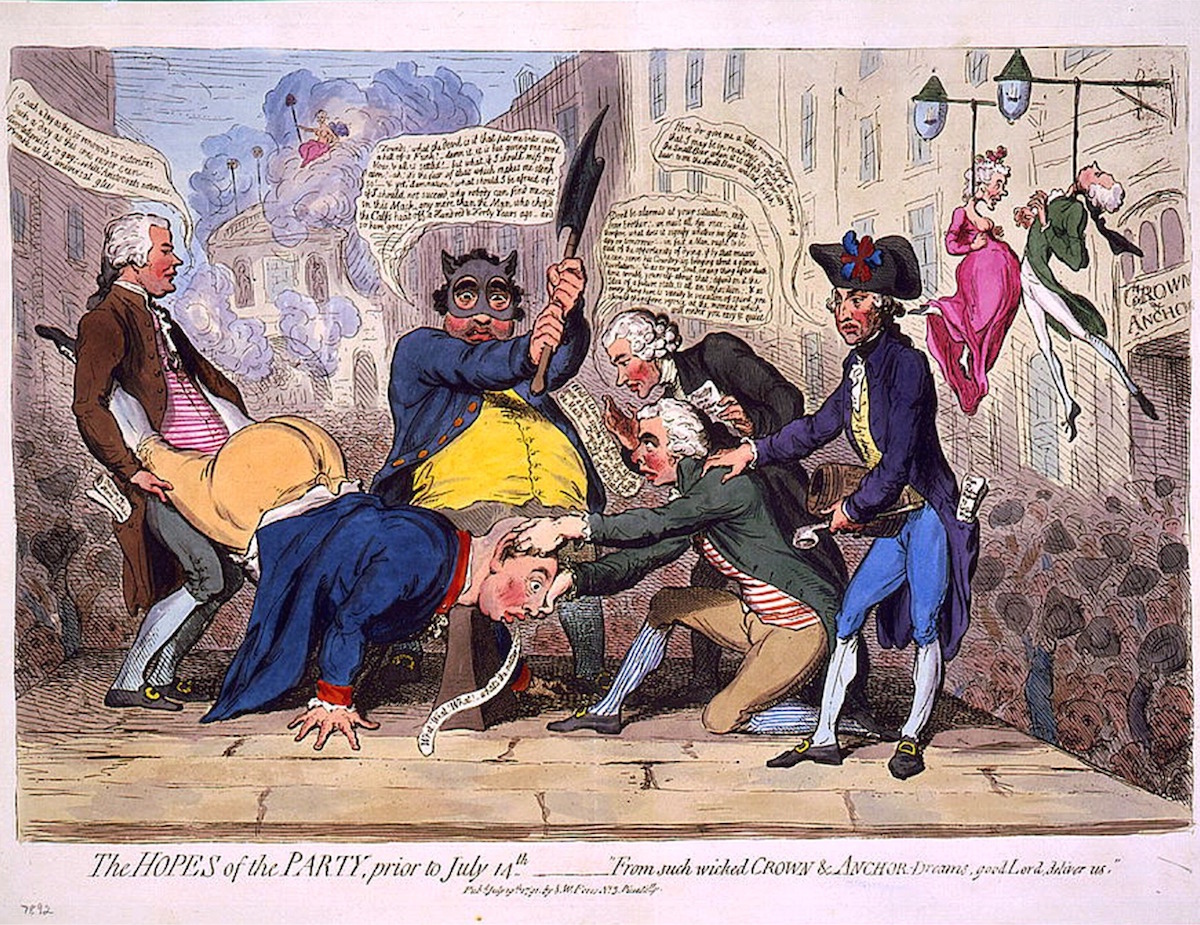The French Revolution political cartoon reflects the prevailing class struggles and resentment towards the monarchy. The French Revolution was a pivotal period in history that significantly impacted the socio-political landscape of France.
The political cartoon encapsulates the sentiments of the time, portraying the discontent and uprising against the ruling class. The depiction of the monarchy and the oppressed citizens in the cartoon provides a visual representation of the power dynamics and the call for change.
Through the use of symbolism and satire, the cartoon conveys the division between the privileged aristocracy and the suffering populace, illustrating the catalysts for revolution. This imagery serves as a stark reminder of the turbulent period and the fervent desire for equality and liberation among the masses.
French Revolution Political Cartoon: Overview
The French Revolution was a period of significant political and social upheaval in the history of France. Political cartoons played a crucial role in shaping public opinion and disseminating political messages during this tumultuous time. This article provides an overview of the impact of political cartoons during the French Revolution, the historical context, key events and figures, as well as the reign of terror.
Understanding The Impact Of Political Cartoons
Political cartoons were a powerful form of communication during the French Revolution, conveying complex political ideas in a simple and visually engaging manner. Artists used caricatures, symbols, and satire to critique the monarchy, government, and social structures, while also mobilizing public opinion and inciting revolutionary fervor.
Historical Context Of The French Revolution
The French Revolution, which began in 1789, was a period of radical ideological and political change. It was fueled by widespread discontent with social inequality, economic hardship, and the oppressive regime of King Louis XVI. The revolution ushered in the era of modern democratic principles, leading to the overthrow of the monarchy and the establishment of the First French Republic.
Key Events And Figures
Key events during the French Revolution included the storming of the Bastille, the Declaration of the Rights of Man and of the Citizen, and the execution of King Louis XVI and Queen Marie Antoinette. Influential figures such as Maximilien Robespierre, Georges Danton, and Jean-Paul Marat played pivotal roles in shaping the trajectory of the revolution.
Reign Of Terror
The Reign of Terror, a period of intense violence and political repression, marked a dark chapter in the French Revolution. Led by the Committee of Public Safety, thousands of people, including perceived enemies of the revolution, were executed via the guillotine. The Reign of Terror underscored the turbulent and volatile nature of the revolution, as well as the radical measures taken to consolidate power.
Visual Satire In French Revolution Political Cartoons
Depiction Of Powerful Symbolism
The French Revolution saw the emergence of powerful political cartoons as a means to express dissent and critique the social and political order. These cartoons utilized symbolism to convey powerful messages and critique the existing power structures.
Analyzing The Use Of Caricature And Symbolism
The use of caricature and symbolism in French Revolution political cartoons played a crucial role in conveying the discontent and social commentary of the time. Caricatures were employed to exaggerate the features of prominent figures, while symbolism was used to encapsulate complex political concepts in digestible visuals.
Representation Of Monarchs And Clergy
Monarchs and clergy were frequent targets of ridicule in these political cartoons, as they symbolized the oppressive ruling class. The cartoons often portrayed them in a negative light, using exaggeration and mockery to highlight the perceived injustices perpetrated by these figures.
Revolutionary Leaders And Commoners
Conversely, revolutionary leaders and commoners were often depicted as heroic figures fighting against the tyranny of the monarchy and clergy. Their portrayal in political cartoons served to galvanize public support and solidify their position as champions of the revolution.
Provocative Symbols In French Revolution Political Cartoons
The use of provocative symbols in French Revolution political cartoons played a pivotal role in conveying powerful messages and inciting socio-political commentary. These symbols deftly captured the tumultuous power dynamics and revolutionary fervor of the time, showcasing distinct visual elements to convey a range of potent messages. This article delves into the symbolic representations of power dynamics, the use of visual elements as tools of political commentary, and the significance of guillotine and liberty cap, as well as the ingenious use of animals and objects to convey profound meanings.
Symbolic Representations Of Power Dynamics
French Revolution political cartoons ingeniously utilized symbolic representations to depict the shifting power dynamics of the era. The intricate visual cues in these cartoons deftly captured the struggle between the ruling elite and the disenchanted populace. Symbolism such as crowns, scepters, and thrones portrayed the monarchical authority, while broken chains and raised fists symbolized the empowerment and resilience of the people.
Visual Elements As Tools Of Political Commentary
The visual elements in French Revolution political cartoons served as potent tools of political commentary, encapsulating the fervent socio-political climate. Skilful use of imagery such as stormy skies, crumbling structures, and torch-wielding masses effectively conveyed the agitation and upheaval prevalent during the revolutionary period. These visual cues served to galvanize public sentiment and reinforce the urgency for change.
Guillotine And Liberty Cap
The guillotine and liberty cap emerged as powerful symbols in French Revolution political cartoons, embodying the revolutionary zeal and the ultimate assertion of liberty. The guillotine, depicted with stark imagery, symbolized the swift and indiscriminate nature of revolutionary justice, evoking fear and uncertainty among the ruling class. Conversely, the liberty cap, often adorned by triumphant revolutionaries, represented the overthrow of oppression and the burgeoning spirit of freedom.
Use Of Animals And Objects To Convey Meaning
French Revolution political cartoons artfully employed animals and objects to convey profound meanings, enriching the visual narratives with layered symbolism. Snakes and rats represented treachery and corruption within the ruling elite, while symbols such as scales and broken chains vividly illustrated the pursuit of justice and liberation. These nuanced depictions added depth to the socio-political commentary embedded within the cartoons, resonating with the populace on a visceral level.
Satirical Techniques In French Revolution Political Cartoons
Understanding The Use Of Satire In Visual Storytelling
The French Revolution political cartoons utilized satire as a potent tool for critiquing the societal and political climate of the time. Satirical techniques in visual storytelling were effectively employed to lampoon and ridicule various aspects of the revolution.
Satirical Portrayal Of Historical Events And Figures
In the context of the French Revolution, political cartoonists used satirical portrayal to depict historical events and prominent figures. By distorting and exaggerating the actions and attributes of key individuals and occurrences, the cartoons conveyed powerful messages of criticism and dissent.
Role Of Exaggeration And Irony
Exaggeration and irony played a pivotal role in French Revolution political cartoons, serving as essential satirical devices. The deliberate amplification of features and situations, coupled with the incorporation of ironic juxtapositions, served to effectively accentuate the underlying criticisms and commentary.
Visual Metaphor In Political Commentary
The deployment of visual metaphor was integral to the incisive political commentary embedded within the French Revolution political cartoons. Through striking visual representations and allegorical imagery, complex political narratives and themes were encapsulated with remarkable clarity and impact.
Impact Of French Revolution Political Cartoons
French Revolution political cartoons had a significant impact on shaping public opinion and fueling revolutionary fervor. These satirical images effectively conveyed political messages and criticized the monarchy and aristocracy, contributing to the spread of revolutionary ideas. The cartoons played a crucial role in mobilizing people and challenging the existing power structures.
Influence On Public Opinion And Political Discourse
The French Revolution political cartoons notably influenced public opinion and political discourse. They were a powerful medium for conveying complex political ideas to the masses in a visually engaging manner. The caricatures and satirical illustrations depicted key political figures and events, shaping public perception and swaying popular sentiment. The cartoons played a pivotal role in forming and molding public opinion during this transformative period in French history.
Legacy Of Visual Satires In Shaping Historical Narratives
The legacy of visual satires from the French Revolution has endured through generations, significantly impacting the shaping of historical narratives. These cartoons have provided valuable insights into the socio-political climate of the time, serving as primary sources for historians and scholars. They continue to offer a unique and engaging perspective on the events and personalities of the era, enriching our understanding of this pivotal period in history.
Reflection Of Societal Views And Attitudes
The French Revolution political cartoons serve as a reflection of societal views and attitudes prevalent during that period. They capture the popular sentiments, values, and concerns of the society at the time, offering a glimpse into the mindset of the people. Through the humorous yet incisive depictions, these cartoons encapsulate the societal dynamics and prevalent ideologies, providing valuable historical and cultural insights.
Role In Political Propaganda And Dissent
The political cartoons of the French Revolution played a crucial role in political propaganda and dissent. They were utilized by different factions to advance their agendas and critique the existing power structures. Serving as potent tools for satire and dissent, these cartoons contributed to the dissemination of political ideologies and the mobilization of public support for various causes and movements during that tumultuous era.

Credit: www.inquiriesjournal.com
Frequently Asked Questions For French Revolution Political Cartoon
What Are Political Cartoons In The French Revolution?
Political cartoons in the French Revolution were visual satires that used humor and imagery to comment on political events and figures of the time. They often conveyed strong messages about the revolution and were a popular form of protest and expression.
How Did Political Cartoons Influence The French Revolution?
Political cartoons played a significant role in shaping public opinion and mobilizing support for revolutionary causes. They were used to criticize the monarchy, highlight social injustices, and rally support for radical ideas. By using powerful imagery and satire, they stirred emotions and swayed public sentiment.
Who Were The Key Artists Creating Political Cartoons During The French Revolution?
Renowned artists such as James Gillray, Jacques-Louis David, and Honoré Daumier were among the key figures producing influential political cartoons during the French Revolution. Their artistic contributions provided a powerful visual commentary on the events and personalities of the time.
What Themes Were Commonly Depicted In French Revolution Political Cartoons?
French Revolution political cartoons often portrayed themes such as the oppression of the lower classes, criticism of the monarchy, calls for liberty and equality, and the brutality of the revolutionary period. The cartoons served as a visual form of propaganda and a means of expressing dissent.
Conclusion
The political cartoons of the French Revolution offer valuable insights into the period’s complexities and conflicts. Through clever imagery and symbolism, these cartoons provide a window into the political and social tensions of the era. Their enduring relevance highlights the power of visual storytelling in understanding history.

